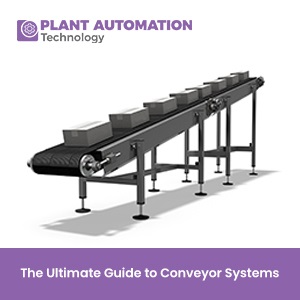The Ultimate Guide to Conveyor Systems

A conveyor system is a mechanical device that moves materials from one place to another. These are common in the material handling and packaging industries for moving bulky or heavy items. They can minimize human error, lower workplace risks, and reduce labor costs.
Working of a Conveyor System
Conveyor systems are part of production processes. It is important to understand how everything fits together when discussing the workings of these systems.
| Also Read: A Comprehensive Guide to Choosing Conveyor Belt Materials for Industrial Automation |
How a Conveyor System Works
The following material concentrates on belt conveying systems, which are the most prevalent, in order to limit the topic of conveying systems.
Belt:
A belt conveyor system uses thick, durable belts that are looped over pulleys. The belt moves between the pulleys when the motor is turned on.
Pulleys:
A driving pulley and a return pulley are required in conveyor belt systems to control the movement of the belt.
Belt Cleaner:
Belts frequently carryback objects. Any carryback that is still on a belt after a load has been unloaded from the belt is removed by a belt cleaning.
Drive:
You can find belt drive in a variety of places on a conveyor, depending on the design. Most belt conveyors use AC motors to power the pulleys that move the belts.
Types of Conveyor Systems
There are several different conveyors. The three most prevalent types are overhead, belt, and roller, with overhead being the two-fold form. Conveying systems benefit large-scale operations.
Belt Conveyors
The most popular and straightforward type of conveyor is the belt conveyor. A belt that supports moving materials moves on a series of rollers or belt-style supports.
Gravity Roller Conveyors
Gravity roller conveyors are a set of rollers connected to a side frame. If a gravity roller conveyor is tilted or mounted on an angle, pieces of various sizes are moved by gravity. Workers must take care to prevent larger items from colliding with smaller ones. Shipping companies employ gravity roller conveyors to load and unload trucks.
Chain Conveyors
Chain conveyors can have multiple chains that make contact with items to be moved. As they are moved, the materials rest on the chains. Chain-driven conveyors are ideal for items with uneven bottoms or ones that are very heavy.
Also read - https://www.plantautomation-technology.com/articles/top-5-conveyor-belt-manufacturers-and-suppliers-globally
Motorized Roller Conveyors
Conveyors use motors to power evenly spaced rollers. Adding motors changes the design such that it resembles a gravity conveyor. It is connected by a chain or belt and sometimes has a sensor that prevents pieces from getting packed together.
Slat Conveyors
Slat conveyors can be used for assembly applications because they can be loaded and unloaded using robotic automation. They are similar to belt conveyors in the sense that their smooth surface prevents damage or harm to items being moved.
Overhead Conveyor Systems
There are different types of overhead conveyor systems, each with a similar function but different designs.
- Enclosed Track Conveyor - An enclosed track conveyor has an enclosure that completely covers trolley connectors, which allows for easier placement of bends and curves in the system.
- Open Track Conveyors - Open track conveyors don't cover the track, making them ideal for long straight configurations.
- Chain Overhead Conveyors - Chain overhead conveyors use a powered chain, fitted at regular intervals with pendants or pusher dogs, that runs along a track. Power and free systems fall under this category.
Monorail Conveyors
Monorail conveyors use the space above production areas and have power supplied by signal lines from conductor lines inside the mounted rails. In order to get out of the way, the carriers first go upward before descending to the level of output.
Power and Free Conveyors
The manufacturing and assembly process uses power and free conveying systems to transport parts through the process so that finished products can travel from station to station while they are being worked on. It is a special kind of overhead conveying system.
Inverted Conveyors
Inverted conveyors are used for power and free conveyance. They usually don't use belts or chains.
Paternoster Conveyors
Paternoster conveyors, also known as platform conveyors, are a vertical conveying system that uses platform carriers attached to a chain drive.
Chute Conveyors
Chute conveyors are made of wood, metal, or plastic and they have an angled surface. Items slid down the surface.
Screw Conveyors
Screw conveyors move bulk substances such as granular products and loose materials. A screw conveyor's central part is a rotating helicoid on a shaft inside a pipe. Screw conveyors are called auger, helix, and spiral conveyors.
Pneumatic Conveyors
Bulk commodities are transported using pneumatic conveyors. A pressurized gas that pushes the material through a sealed pipeline lifts and moves it through the pipe as pressure builds.
Vibratory Conveyors
Vibrating conveyors use vibrations to move materials along a conveying trough. They're ideal for moving grains, food products, and mined materials. Vibrating conveyors have a specific design to fit their function, and they are especially good at moving products in harsh environments.
Chain on Edge Conveyors (COE)
A chain on edge conveyor (COE) is a single strand chain conveyor (SSCC) capable of flexing along the horizontal axis and making horizontal turns and vertical curves. Various types of twists and turns make COE more versatile than traditional chain driven conveyors.
Skid Conveyor
Skid conveyors move products on fixtures with longitudinal runners called skids. Skid conveyors are valued for their efficiency and quiet movement.
Friction Conveying System
A friction conveying system is a safe alternative to power and free systems. It consists of a friction drive, load bearing track, switch, stopper, trolley, elevator and steel structure with the major benefit of operating cleaner and quieter.
Why Conveyor systems are Crucial to Industrial Automation
Conveyor systems can be used in a wide range of industrial sectors for a variety of processes, including production, packaging, and even delivery.
Reduces Manual Waste
Certain tasks in a process can be done without manual labor. In fact, you can reduce this by automating such tasks. In a production line, conveyors will not only expedite the procedures but also increase plant productivity.
Provides Flexibility
Conveyors that are modular help achieve the flexibility needed for diverse applications. Additionally, they are simple to put up in the field as well.
Enhance Quality Control
Automation helps in the identification of significant product flaws like faulty components and unwanted metal, among others. Conveyor solutions aid in orienting products for the subsequent assembly or operation, preventing time from being lost to product repositioning.
You can integrate a variety of technologies into your manufacturing and/or production unit. Conveyors are guaranteed to stand out as the winner among them.
Application Systems for Conveyors
Conveyors are used in a variety of sectors, including those that produce food, automobiles, bottles, pharmaceuticals, aerospace, chemicals, and many more. Conveyors are frequently used for buffering, storage, and transportation.
Benefits of the Conveyor System
When seen as a mechanical method of transferring bulk materials, it has various benefits. Well, the benefits of a conveyor system are as follows:
- One of the cheapest methods for moving material over large distances is a conveyor system.
- The material can be seen on the conveyor belt while it is conveying and the conveyor's height may change.
- Belt conveyors may be equipped with metal separators and trippers that allow the belt to be unloaded practically anywhere.
- The discharge can be moved in an arc by turning a belt conveyor at one end. The belt can also be given sidewalls to stop product spillage.
- For continuous product weighing, weigh belt sections can also be attached to conveyors.
Cons of the Conveyor System
The following are a conveyor system's drawbacks:
- The belt conveyor's general layout is opened. Therefore, a product fall is a possibility. It can get expensive if you have to install covers.
- Sticky substances have a tendency to get stuck on belts and spread to the return side, rolls, idlers, and pulleys.
- When the material is sticky, cleaning the belt can be challenging and frequently fails, necessitating a belt replacement.
- Belt discharge almost always involves the discharge of material, which causes a maintenance issue.
- Controlling odors is quite difficult.
| Also Read: Innovations in Industrial Conveyor Belt Technology: Enhancing Safety and Performance |
SUMMARY
Conveyor systems are used in almost every sector.
They help in completing various tasks, and by automating them, you can gain the extra benefits of flexibility and safe procedures. Additionally, they support improving the efficiency and cost-effectiveness of your processes.







